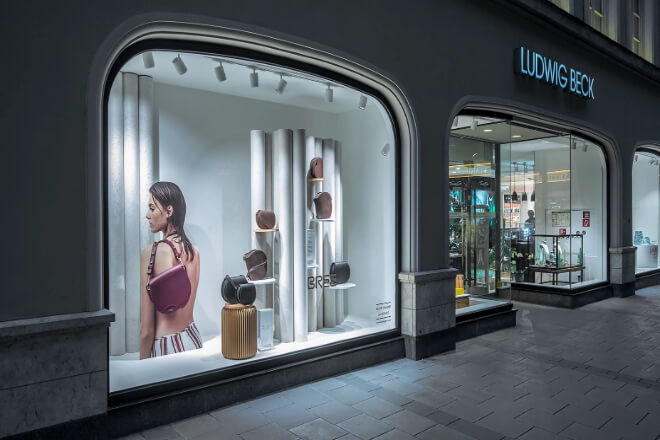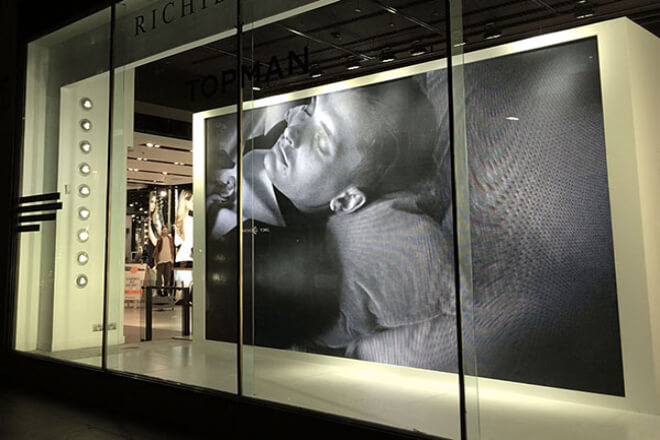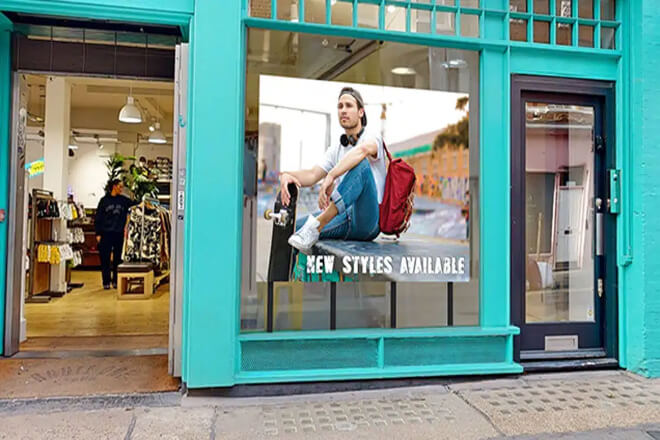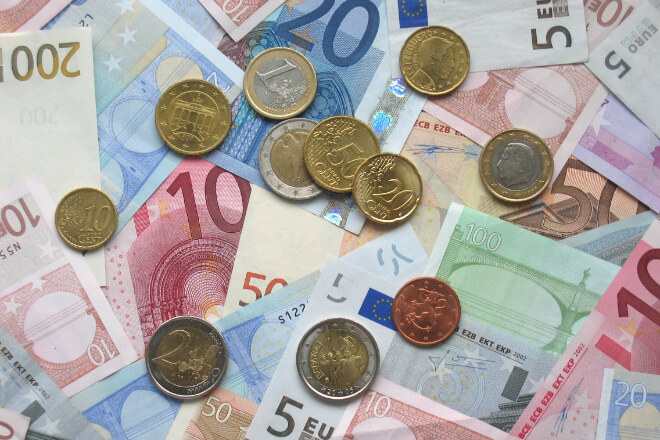介绍
Want to upgrade your window but not sure whether to install an LED display? Don’t worry, and this article is tailor-made for you.
It can help you judge whether the window is suitable for installing LED显示屏 from multiple angles so that you can make a decision without panic.
目录
Step 1: Consider the physical space conditions of the window

1). 测量与计算
Don’t rush to do it; take out your tape measure and carefully measure the length, width, and height of the window.
This is like a tailor measuring your body for clothes. If the size is accurate, there will be no problems later.
After measuring, you will have a rough idea of how big the LED display can be installed in this window.
If the window is two meters wide and one and a half meters high, the display cannot fill the entire space at once. You have to leave some corners for the frame and bracket.
Therefore, the maximum size is about 1.8 meters wide and 1.3 meters high.
2). The ratio of display screen size for windows of different sizes
2.1). Small boutique window
The window of a small boutique is really small and exquisite, with an area of only one or two square meters.
In such a place, installing a display screen that is too large is like a small horse pulling a big cart, which is out of proportion.
Generally speaking, a screen ratio of 16:9 or 4:3 is a good choice. For example, a small window of two square meters.
Installing a 0.8-meter-wide and 0.6-meter-high display screen will not make it empty or crowded, and it can display product information clearly.
2.2). Brand window of a large shopping mall
The brand window of a large shopping mall is much more spacious, with an area of 10 square meters or even larger.
Such a large scene naturally needs a large-size display screen. The screen ratio is also recommended to be 16:9 or 4:3.
For example, a large window of ten square meters is equipped with a 2.5-meter-wide and 1.5-meter-high display screen, and the visual effect is quite shocking.
Customers can be attracted from a distance, and a lot of content can be displayed, showing brand features and new product information all at once.
Step 2: Technical parameter adaptability for LED display screens

1). 解决 and picture clarity requirements
In simple terms, resolution is the number of pixels on the screen. The more pixels, the clearer the picture.
Just like when you were a kid drawing with colored pencils, the more detailed the drawing, the better the pattern.
For a 1080p screen, the pixels are like a piece of ordinary drawing paper, which allows you to see the general content of the picture.
For a 4K screen, it is like using a finer piece of drawing paper with richer picture details and brighter colors.
An 8K screen is even more powerful, just like looking at a picture with a microscope; every detail can be seen clearly.
观看距离 is also important. If customers are close, like in a small window in a boutique, they get close to see the product, then the resolution must be higher, and a 4K or 8K screen can allow them to see every detail of the product.
If you are far away, like in a large window display in a large shopping mall, a 1080p screen is enough because the human eye does not require so much detail from a distance.
When choosing a screen, you should also consider the size and purpose of the window. The windows of small boutiques are generally small, and customers are close.
If the window area is 1-3 square meters and the display size is about 0.5-1 square meters, then a 4K display is quite suitable.
For example, when displaying jewelry, the high resolution of 4K allows customers to see every detail of the jewelry; even the cut surface of the gemstone can be seen clearly.
The window area of a large 购物中心 is large, and customers are far away. If the window area is more than 10 square meters and the display size is about 2-3 square meters, a 1080p display is enough.
For example, when displaying a new product series of a clothing brand, the 1080p picture is bright and smooth when viewed from a distance, which can show the overall style of the clothing, and the cost is relatively low.
2). Consideration of 刷新率 and dynamic picture smoothness
The refresh rate is like the “refresh speed” of the picture, and the unit is Hertz (Hz). The higher the refresh rate, the faster the picture updates and the smoother the dynamic picture.
If the refresh rate is low, it will be like watching an old movie; the picture will be stuck, and the image will be smeared, which is particularly uncomfortable to watch.
Different window display contents have different requirements for refresh rate. For example, in fashion show videos, models walk around on the catwalk, and the picture moves quickly.
If the refresh rate is low, the model’s catwalk movements will be stuck, and the image will be seriously smeared, affecting the visual effect.
For this kind of content, the refresh rate must be at least 60Hz, and it would be better if it could be increased to 120Hz so that the picture is as smooth as the real thing.
Product dynamic demonstration, such as showing the working process of electronic products, also has many dynamic elements in the picture. In this case, a refresh rate of 60Hz can basically meet the needs.
If you want to show some particularly fine dynamic effects, such as the internal operation of mechanical products, a refresh rate of 120Hz can make the picture clearer and smoother so that customers can better understand the performance of the product.
In short, choosing the right resolution and refresh rate can make the window display effect even better, attract customers’ attention, and enhance the brand image.
Step 3: Evaluate the convenience of installation and maintenance

1). Complexity and cost of the installation process
Installing an LED display in a window requires careful consideration. First, you have to lay out the lines, which is like building “blood vessels” for the screen to allow the current to flow smoothly.
Next is the installation of the fixture. The screen must be firmly fixed in the window. Otherwise, the screen will not be able to “stand” steadily.
Finally, the screen is debugged. This step is like a “physical examination” of the screen, adjusting the 亮度, color, etc., to ensure that the screen can work properly.
Different installation methods have different complexity and costs. For example, wall-mounted, just like hanging a painting on the wall, is relatively simple and has a lower cost.
But if it is embedded, it is much more complicated. You have to dig a hole in the window and consider how to route the line, so the cost will naturally go up.
Generally speaking, the wall-mounted installation is relatively simple, mainly labor costs and some simple bracket costs.
Embedded installation, because it requires more structural changes and lines hiding in the window, will cost relatively high.
However, the specific cost must be determined according to factors such as the size of the display, the complexity of the installation environment, and the height of the installation location.
2). Convenience and cost of maintenance
Maintaining the LED display is like giving it regular “beauty” and “physical examinations.” Daily maintenance includes cleaning the screen, which is like “washing the face” of the screen to ensure a clear picture.
Check the line to ensure that the “blood vessels” are unobstructed; update the software to keep the screen “young.”
These maintenance tasks can not only extend the service life of the display but also maintain a good display effect.
Different types and brands of LED displays have different maintenance difficulties and costs. Some displays are more reasonably designed, which makes maintenance easier and less expensive.
For example, for front maintenance of LED screens, maintenance personnel can directly enter the interior of the display from the front for maintenance, saving time and effort.
Some displays may require the entire screen to be disassembled for maintenance, which is much more troublesome.
It is important to choose display products that are easy to maintain, which can reduce long-term operating costs.
For example, although COB LED display screens have higher initial purchase and installation costs, they have a long service life and low maintenance frequency, which may be more cost-effective in the long run.
Step 4: Comprehensive trade-off between budget and cost-effectiveness

1). Initial investment cost analysis
When installing an LED display screen, you must first calculate how much money you will spend. This matter should be divided into several pieces.
Let’s talk about the display screen itself first, which is the biggest expense.
There are many kinds of display screens on the market, and the price difference is large when there are many brands, models, and specifications.
The display screens of big brands are reliable in quality, but the price is also high; small brands may be cheaper, but you have to worry more about the quality.
In addition, the larger the display screen, the more expensive it will definitely be, just like buying a TV; the larger the size, the higher the price.
The installation cost cannot be ignored. This depends on how you install it and the structure of the window. If the window structure is simple, it will be easy to install and cost less.
If the structure is complex, it will be difficult to install, and the cost will naturally be high.
For example, the installation of a wall-mounted display is relatively simple, and the cost is probably a small part of the price of the display screen.
An embedded display is more troublesome because it needs to be more involved in the window, so the cost will be higher.
Then, there are the supporting facilities, such as players, network equipment, and so on. Players are necessary.
Without them, the display screen is “dumb.” The more functions the player has, the more expensive it is.
There is also network equipment, which must be used if you want to remotely control the display screen, which is another expense. These supporting facilities together account for a small part of the total project cost.
Adding up these costs, you can roughly calculate the initial investment cost of the entire project.
The specific cost depends on the size, brand, installation method, and display screen conditions.
However, generally speaking, the initial investment cost of the entire project is about more than one to more than two times the price of the display screen, and the specific situation depends on the actual situation.
2). Long-term operating costs and expected benefits
After installing an LED display screen, the money spent is not over yet, and you have to consider the long-term operating costs and the benefits it can bring.
Let’s talk about operating costs first. First of all, there is the electricity bill. Although the LED display is energy-efficient, it still costs money to keep it on all the time.
The larger the display, the higher the electricity bill. If it is turned on for ten hours a day, the electricity bill will cost several hundred yuan a month.
Then there is the maintenance cost. The display needs to be cleaned regularly, the lines checked, and the software updated, all of which cost money.
If the display is of good quality, the maintenance cost can be lower; if the quality is poor, the maintenance cost will be higher.
Generally speaking, the annual maintenance cost accounts for a small part of the price of the display.
Finally, there is the content update cost. If you want to keep the display content constantly updated and attract customers, you have to update the content regularly.
It costs money to make new advertising videos, pictures, etc. The more complex the content and the higher the production quality, the higher the cost.
Let’s talk about the benefits. Installing an LED display is not just about spending money but also brings many benefits.
First of all, LED displays can make the window more attractive. When customers pass by, they will be attracted, and the probability of entering the store will increase.
Data shows that customers stay longer in a window with an LED display than in an ordinary window.
Secondly, by playing product advertising videos and detailed introductions on the display, customers can better understand the product, thereby promoting sales.
There are cases showing that after installing an LED display, product sales have increased a lot.
Finally, a high-tech, modern display can make the brand image more high-end and fashionable.
This is an intangible asset for the brand, which can enhance the brand’s value and competitiveness.
Merchants can evaluate the return on investment based on factors such as the size and location of the display.
Generally speaking, by increasing sales and brand image, merchants can recover their costs within a few years, and then it will be pure profit.
5. 结论
Through the detailed introduction of this article, I believe you have a clearer understanding of how to judge whether a window is suitable for installing an LED display.
From the consideration of physical space to the selection of technical parameters, from the convenience of installation and maintenance to the balance between budget and cost-effectiveness, every link is crucial.
LED displays can not only enhance the attractiveness of windows but also promote sales and enhance brand image.
最后,如果您想了解更多关于LED显示屏的知识, 请与我们联系.
